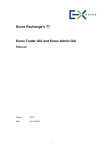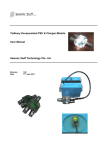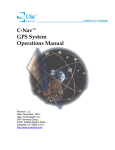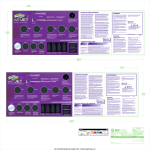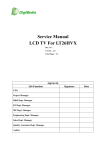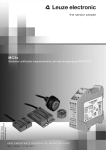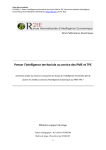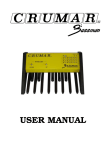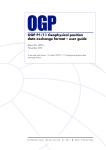Download Cruise MGL0807 - Marine Geoscience Data System
Transcript
Job Book with Nav/Positioning Report Client: Lamont Doherty Earth Observatory Description: Cruise MGL0807 Cruise start date: March 19th 2008 Cruise end date: April 16th 2008 Revision History Version 1.0 1.1 1.2 Description Initial Draft Additional Notes Parameters Added Job Book ver. 1.0 Date Approved 03/18/2008 04/15/2008 04/16/2008 Page 2 Table of Contents Revision History ........................................................................................................................................................................... 2 Table of Contents.......................................................................................................................................................................... 3 Introduction ................................................................................................................................................................................... 3 HSE................................................................................................................................................................................................ 4 Emergency Response Plan ...........................................................................................................................................................5 Job Specifications ......................................................................................................................................................................... 6 Geodetics.......................................................................................................................................................................................6 Deliverables ..................................................................................................................................................................................6 Deliverable Templates.................................................................................................................................................................. 7 Daily Log / Line Report ...............................................................................................................................................................7 Sequence / Line report.................................................................................................................................................................. 8 Area of Operations........................................................................................................................................................................ 8 Personnel ....................................................................................................................................................................................... 9 Client Contacts.............................................................................................................................................................................. 9 NCS Personnel .............................................................................................................................................................................. 9 NAVIGATION / QC ..................................................................................................................................................................10 SPECTRA ...................................................................................................................................................................................10 Data Acquisition ......................................................................................................................................................................... 11 Positioning...................................................................................................................................................................................11 GPS ..............................................................................................................................................................................................11 Gyro .............................................................................................................................................................................................12 Energy Source .............................................................................................................................................................................12 Cable Compasses ........................................................................................................................................................................12 PosNet..........................................................................................................................................................................................13 Streamer Cable Composition .....................................................................................................................................................13 Streamer Layout.......................................................................................................................................................................... 15 Acoustic’s....................................................................................................................................................................................16 Multibeam echosounder .............................................................................................................................................................17 Water Column Velocity of Propagation....................................................................................................................................17 Navigation Data Processing .......................................................................................................................................................17 Navigation Antenna Offsets.......................................................................................................................................................18 FRONT-END OFFSETS............................................................................................................................................................19 FRONT-END OFFSETS (continued) .......................................................................................................................................20 FRONT-END OFFSETS (OVERHEAD VIEW).....................................................................................................................21 FRONT-END OFFSETS (OVERHEAD VIEW – continued) ................................................................................................22 Acoustic Overhead View ...........................................................................................................................................................23 LANGSETH GUN ARRAY LAYOUT....................................................................................................................................24 SUB-ARRAY LAYOUT ...........................................................................................................................................................25 TAILBUOY CONFIGURATION .............................................................................................................................................26 Positioning Summary .................................................................................................................................................................27 Processing Summary ..................................................................................................................................................................27 SCN revision history: .................................................................................................................................................................28 Introduction NCS SubSea, Inc. has been contracted to provide positioning and navigation processing services for the operation of Spectra, which accurately plots the ships position in realtime, and Sprint, used to processes the data for a final product. Job Book ver. 1.0 Page 3 HSE NCS conducts its business with the utmost regard for the Health and Safety of our employees, and respect for the environment. All employees are empowered to stop work immediately in the presence of an uncontrolled hazard. Every employee must be provided access to the appropriate Personal Protective Equipment (PPE) to ensure protection from hazards. No NCS employee is permitted to intentionally damage the environment through the emission of any substance in any form. All NCS employees working offshore are required to pass Medical evaluations conducted by Methodist Hospital in Houston, Texas. The evaluations are conducted every two years to the Schlumberger Medtrack standard. Similarly all personnel are required to pass Sea Survival and Helicopter Underwater Egress Training (HUET) every three years in a US Coast-Guard approved facility. Job Book ver. 1.0 Page 4 TITLE MEDICAL PROCEDURES REVISION NO: 2 DATE EFFECTIVE APR. 23, 2005 SECTION: 9.1. ORIGINATOR: Michael Rawson APPROVED BY: Paul W. Ljunggren PAGE Page 1 of 1 Emergency Response Plan Medical Procedures 1. Scope This section describes the procedures for treation medical problems onboard a research vessel(s) operated by Lamont-Doherty Earth Observatory Office of Marine Operations (OMO). Any injury or seckness, no matter how minor should be reported to a supervisor or medical person in charge as soon as possible. 2. Teatment of Medical Condition 2.1. The L-DEO research vessel(s) as are all UNOLS ships, is a subscriber to the Medical Advisory Service (MAS) which is on call 24 hours per day to provide medical advice via the Inmarsat telephone: 2.1.1. Determination of extent of injury or sickness. 2.1.2. Advice on procedures for treating illness or injury. 2.1.3. Provide contact with nearest medical facility if needed. 2.2. Instructions for making contact with MAS are detailed in the MAS Medical Protocol Handbook in the ship’s Hospital library (Section 9.1.1.) 2.3. Treat the injury or sickness as per medical protocols from the hospital library reference materials (Hospital Library (Section 9.1.1) with medical inventory on board (ref: Quarterly Medical Inventory sheets). 2.4. Document all treatment that is prescribed through the MAS in ship’s medical log. All faxes or telexes relating to the treatment should be filed in the personal file of an injured or sick party. Treatments for minor injuries or maladies do not need to be logged. 3. Medications 3.1. All medications maintained by the vessel as medical inventory are stowed in the Ship’s Hospital on the aft Port side of A-Deck. 3.2. Medications and emergency medical supplies are inventoried every three months. 3.3. No medication is prescribed unless administered by Captain or Chief Mate. 4. Serious Injury Situation 4.1. Reference should be made to the MAS Medical Protocol Procedures Manual (Section 9.1.1. Hospital Medical Books Library) to determine if an injury is serious enough to contact the medical advisory service. 4.2. If an illness or injury is serious, the MAS should be contacted by telephone or fax. 4.3. In the event of a serious injury, illness or accident, the Columbia University Accident Report should be completed per instructions in Section 12. and 12.5 in the Administrative Procedures manual. 5. Life Threatening Situation 5.1. In the event of life threatening injury or accident, in consultation with the medical advisory service, Chief Scientist and the Designated Person at the Office of Marine Operations, consider diverting to nearest port for advanced medical treatment. 5.2. Notify the appropriate national authorities, and if possible, arrange medical evacuation at sea. The following references should be consulted in the event of a medical diversion: 5.2.1. Medical Advisory Service (Manual, Hospital Library) 5.2.2. Agent’s list 5.2.3. Contact numbers in List of Radio Determination and Special Stations. 6. Chemical Testing 6.1. In the event of a serious marine accident as defined in 46 CRF4.03-2, chemical testing shall be carried out as specified in 46 CRF 4.06. Job Book ver. 1.0 Page 5 Job Specifications Geodetics MGL0807 Satellite Datum WGS-84 MGL0807 Survey Datum WGS-84 Spheroid Name: Unit: WGS-84 Meter Semi-Major Axis Inverse of Flattening Semi-Major Axis : 6378137.000 Semi-Minor Axis: 6356752.31424518 6378137.000 Flattening: 0.003352810665 298.257223563000 Inverse of Flattening: 298.257223563000 UTM Projection – Hemisphere North – Zone 16 Deliverables Description P1/90 Processed Data P2/94 Raw Data Daily Log Job Book/Final Report Job Book ver. 1.0 Media Frequency Comments Job Completion See contents below Page 6 Deliverable Templates Daily Log / Line Report Job Book ver. 1.0 Page 7 Sequence / Line report Area of Operations This is a continuation of work done on trip MGL0804 done on the Caribbean side of Costa Rica and Nicaragua. This work will be done on the Pacific side of the same two countries. Job Book ver. 1.0 Page 8 Personnel Client Contacts Name Al Walsh Position Project Leader Cell Phone E-Mail [email protected] NCS Personnel Name Stuart Porteous Al Hise David Martinson Mike Martello Job Book ver. 1.0 Position VP Operations Prod Line Mgr. Technician Party Manager Cell Phone 832 689-0179 832 495 2018 281-491-3123 228 238 1368 E-Mail [email protected] [email protected] [email protected] [email protected] Page 9 NAVIGATION / QC SPECTRA Spectra is a comprehensive integrated seismic navigation system with a modular design, which allows any innovations in navigational techniques to be applied quickly. Spectra is based on an expandable network of Unix or linux workstations with a dedicated real time navigation sensor acquisition system RTNu providing access to a tried and tested database of over 100 different navigation sensors and closure timing to a 50 micro-second resolution. Benefits of spectra • • • • • • • • Navigation acquisition and validation with real time source and streamer positioning for marine seismic surveys ranging from simple 2D and high resolution requirements to extensive 3D multi-streamer, multi-vessel configurations. Distributed Data Server provides simple connectivity to easily configure complex multivessel surveys. Real-time data acquisition units with integrated GPS receiver provide triggering to 50 micro-seconds, allowing remote synchronization of seismic and acoustic systems. Data logging to UKOOA P1/90, P2/91 and P2/94 standards with full redundancy, providing confidence in data integrity. Quality Control features providing alarm and audit facility meeting UKOOA guidelines. Extensive on-line graphical analysis features and end of line reporting facilities. Positioning using Kalman filtering with advanced data-probing statistical testing techniques. DGPS and RGPS real-time recomputation. Autopilot interface controlled from instrument room leaving the navigator in charge of steering. This facility is fully integrated with a comprehensive turn planning utility, providing optimum efficiency in line changes. When used for 3D: For 3D use: real-time binning, CMP and offset distribution displays. Fully compatible with Concept Systems off-line binning and analysis package including bin expansion capabilities. Job Book ver. 1.0 Page 10 Data Acquisition The seismic data will be acquired using a Marconi Solid Cable system. Sections - 150m -sections to compose the streamer will be used to acquire 636 channels of data on the 24 bit system. Positioning Vessel positioning will be achieved using the Spectra Totally Integrated System, provided by LDEO, which accurately plots the ships position in realtime. The system generates signals by which the “DigiSHOT” commands the Air Guns to fire at pre determined intervals, based on either distance or time as previously determined. This “trigger” also signals the Syntrak 960 -24 recording system to record seismic data from the 8.1km streamer cable, when used. Real Time positioning of the source and tailbuoy will be achieved with PosNet, a remote gps system which can gives a direct range and bearing in realtime for all events. GPS The C-Nav GPS Receiver combines a dual-frequency, geodetic grade, GPSReceiver with an integrated L-BAND communication RF detector and decoder all linked by an internal microprocessor. Corrections are supplied through satellite link, thus giving a GPS Quality indicator of 2 or GcGPS Corrected Fix. Seapath 200 is a stand-alone system, which does not require input of data from any other sensors in order to provide accurate heading, roll, pitch and heave. Seapath requires input of DGPS corrections. Seapath provides a real-time heading, attitude, position and velocity solution by integrating the best signal characteristics of two technologies, Inertial Measurement Units (IMU’s) and he Global Positioning System (GPS). Seapath utilizes the proven and reliable Seatex MRU 5 inertial sensor and two GPS carrier phase receivers as raw data providers. The raw sensor data are integrated in a Kalman Filter in the Seapath Processing Unit. The Kalman filter is a proven and effective filtering technique for integration of various sensors in a realtime environment, and the filter output provide heading, attitude, and position data required in survey applications. POS/MV – Uses three sensors – the Inertial Measurement Unit (IMU) and two Global Position System (GPS) receivers. These allow the System to deliver an accurate and comprehensive data set, including: • Geographic position (latitude, longitude and altitude) • Heading • Attitude (roll and pitch) • Vertical displacement (heave) • Velocity • Acceleration • Angular rate of turn • Performance metrics • Fault detection and reporting Job Book ver. 1.0 Page 11 Gyro The Simrad GC80 gyro has been designated for any size vessel, to enhance the navigation capabilities and reliability. This is done by using basic gyroscopic action to form a stable directional platform. When the 3 axes (spin axis, horizontal axis, and vertical axis) of the gyro reach a high stable revolution rate, the compass card reflects the True heading in relation to north. This is a factory preset, where a weight is added to the vertical ring (axis). Another, smaller weight is added to the sphere giving a damping effect to the oscillations created by the vertical ring weight. The GyroCompass north-seeking tendency depends upon the fact that north is a right angles to the westto-east direction in which the earth’s rotation carries the compass. A high degree of accuracy is maintained by the use of scheduled “calibration checks” where slight fluctuations (if any) are compensated in Spectra. Energy Source The energy source is a 4 string array, utilizing Bolt internal shuttle guns. Each sub-array dimensions are 16 meters in length with a sub-array cross line separation of 8 meters, and are composed of 10 guns with 1 of the 10 being a “spare” gun leaving a 1650cu in volume per string. Without the “spare” guns, a total volume of 6600 cu in. is reached. Source synchronization is achieved with a DigiSHOT Seismic Source Controller System. The DigiSHOT control’s all airguns within the same array. The timing for each gun is individually controlled. The system collects and displays graphically the sensor data for all guns in the array. It also collects and displays the gun depth and air pressure supplied to each string. The sensor data is used to detect when the airgun was triggered and to make the necessary adjustments to airgun timing. The DigiSHOT system provides timing resolution of 0.1ms. Source positioning will be derived by nominal value and actual RGPS range and bearings, and acoustic positioning pods. Cable Compasses Digicourse Model 5011 Compass Birds will be distributed along the streamer, and used to model the cable shape for the positioning of the receivers. These compasses will be present at every 300 meters. The Model 5011 Compass Bird provides adjustable depth control, depth measurement, ballast information, and compass heading. The heading sensor is a compass designed for instreamer installation. A digital number (indicative of orientation relative to magnetic North) is latched to a serial pulse train output. All information is transferred to the streamer “coils” when polled and returned to the vessel by wire to the Digicourse computer and to Spectra. Job Book ver. 1.0 Page 12 PosNet Designed to work with SARGAS reference stations, PosNet can be used in areas where coverage is not available, such as the Costa Rica and Nicaragua waters, where our survey is located. The relative position accuracy of the local targets: gun pods, tailbuoy, is unaffected, as they are independently estimated relative to the vessel, and the vessel position is known sufficient accuracy even without any DGPS correction to obtain sub meter target relative position to the ranges that are used for these operations. All raw and computed data may be recorded. The Windows XPTM based computer used by PosNet is networked to Spectra and all received data is available for use. GUN POSNET PODS One located on each outside gun string, 23cm behind the center of source, for a total of 2. TAILBUOY POSNET POD One located on tailbuoy. Streamer Cable Composition Job Book ver. 1.0 Page 13 1. Lead-in – Heavy armored cable that that packages the wires and fiber optics and is used to provide the offset from the vessel to the first active section. And to communicate (send/receive) information from the streamer. 2. RVIM – head stretch between the lead in and STU. Its length is 30m upon deployment, and it acts as a “shock absorber” reducing the effect of the vessel’s movement upon the deployed streamer in the water. 3. STU –streamer tension unit is incorporated in order to monitor the tension upon the streamer. This is to protect the steamer from unnecessary “pull” causing damage or loss of streamer. The streamer is a Syntron Sentry Solid streamer. 4. Length of the “active streamer” is 8100 meters and is composed of 54 x 150 meter long active sections. These sections are connected by modules which control the data flow. Each section contains “communication coils,” located at known positions on the cable, and is used to communicate to “cable levelers, compasses, depth indicators.” This same “coil” can also communicate with the acoustic pods. All is monitored by Spectra and its QC. 5. Tail Stretch is located at the end of the active streamer, after a passive module that terminates the streamer. The 50m tail-stretch, is used similarly as the head-stretch, to reduce unwanted tugging on the streamer. 6. Stic-cable, 75m, is used to send power to the active TailBuoy, for the electronics located there, RGPS, acoustic pod, and radio modem. This data is then, by radio link, sent to the vessel and Spectra. The active tailbuoy GPS will provide for accurate rotation of the streamer to the tailbuoy in processing, providing a highly accurate streamer shape. Job Book ver. 1.0 Page 14 Streamer Layout S1C1 S1C2 S1C3 S1C4 S1C5 S1C6 37.96 -261.04 -561.04 -861.04 -1161.04 -1461.04 S1C7 S1C8 S1C9 S1C10 S1C11 S1C12 -1761.04 -2061.04 -2361.04 -2665.05 -2961.05 -3261.05 S1C13 S1C14 S1C15 S1C16 S1C17 S1C18 -3561.05 -3861.05 -4161.05 -4461.05 -4761.05 -5061.05 S1C19 S1C20 S1C21 S1C22 S1C23 S1C24 -5361.05 -5661.05 -5961.05 -6261.05 -6561.05 -6861.05 S1C25 S1C26 S1C27 S1C28 S1T1 S1T2 -7161.05 -7461.05 -7761.06 -7911.06 ***** ***** G1T1 G1T2 G1T3 G1T4 These S1 Compass offsets are referenced to center near group (cng). For acoustic offsets – see reference pages. Job Book ver. 1.0 Page 15 ***** ***** ***** ***** Acoustic’s SIPS is the Seismic Integrated Positioning System manufactured in the U. K. by Sonardyne International Ltd. SIPS is designed for use on marine seismic survey vessels as an acoustic positioning system for airgun arrays, streamers and tailbuoys. In use for this survey is the 1 way ranging transceiver model number 7785. The basic operation method of SIPS is the measurement of ranges between in-water units of a seismic system so their relative positions can be calculated. The distance between units are measured using the principle that sound travels through water at a predictable speed. By measuring the time for sound to travel between two points the range can be calculated. Multiplying the travel time by the speed of sound gives the distance travelled. The sound used by the SIPS system are very short pulses of a constant high frequency. The Sips system uses intelligent acoustic transceivers placed at reference points that need to be positioned. The Transceivers have a digital data link with the shipborne equipment to transfer the measured range data. The devices are also controlled from the surface system using these data links. The units mounted on the streamers are battery powered and use the streamer embedded coil communications system. Other units are hard wired into the surface system using dedicated communications links. For other applications a radio modem link can be used to communicate with transceivers. A transceiver is an intelligent unit which can be used to measure distances underwater. SIPS transceivers are commanded by Controller boards mounted in the SIPS Controller rack. The Controllers send commands to the transceivers to initiate the ranging process and then request range data from the transceivers. Transponder units do not have an associated Controller card. A Transponder will transmit an acoustic reply after a preset interval when a particular acoustic signal is received from a transceiver. Locations: One on each gun string for four; and two on the streamer head for a total of 6. Job Book ver. 1.0 Page 16 Multibeam echosounder The EM 120 multibeam is designed to perform seabed mapping to full ocean depth. The system is cost effective, reliable, and easily operated on workstations with familiar operating systems. Key facts The Kongsberg Maritime product is designed to perform seabed mapping to full ocean depth with an unsurpassed resolution, coverage and accuracy. The design is based on more than 50 years of hydrographical experience with echo sounders, sonars and underwater positioning for civilian and military use. The EM 120 is a complete system. All necessary sensor interfaces, data displays for quality control and sensor calibration, seabed visualization, and data logging are a standard part of the system, as is integrated seabed acoustical imaging capability (sidescan). The nominal sonar frequency is 12kHz with an angular coverage sector of up to 150 degrees wand 191 beams per ping as narrow as 1 degree. Achievable swath width of a flat bottom will normally be approximately six times the water depth. The angular coverage sector and beam pointing angles may be set to vary automatically with depth according to achievable coverage. This maximizes the number of usable beams. The EM 120 transducers are linear arrays in a Mills cross configuration with separate units for transmit and receive. The arrays are divided into modules (and hence the beamwidth) may be adjusted according to particular installation requirements. A combination of phase and amplitude detection is used, resulting in an instrument measurement accuracy practically independent of beam pointing angle. Water Column Velocity of Propagation Water velocity for the survey will be assumed at a static 1500 m/sec except for seismic processing. Navigation Data Processing Not a prerequisite for this survey. Sprint is available. Job Book ver. 1.0 Page 17 Navigation Antenna Offsets Job Book ver. 1.0 Page 18 FRONT-END OFFSETS Job Book ver. 1.0 Page 19 FRONT-END OFFSETS (continued) Job Book ver. 1.0 Page 20 FRONT-END OFFSETS (OVERHEAD VIEW) Job Book ver. 1.0 Page 21 FRONT-END OFFSETS (OVERHEAD VIEW – continued) Job Book ver. 1.0 Page 22 Acoustic Overhead View Job Book ver. 1.0 Page 23 LANGSETH GUN ARRAY LAYOUT Note: Gun #5, on all strings, is spare gun. Note: Gun strings 2 & 3 do not have rgps on this survey. Job Book ver. 1.0 Page 24 SUB-ARRAY LAYOUT Note: MGL0807 do not have rgps on strings 2 & 3 Job Book ver. 1.0 Page 25 TAILBUOY CONFIGURATION Job Book ver. 1.0 Page 26 Positioning Summary Processing Summary ADDITIONAL NOTES: Job Book ver. 1.0 Page 27 SCN revision history: File Name MGL0807.SCN (001) rev. # seq effected 1 1 3 44 date 20-Mar08 22-Mar08 22-Mar08 23-Mar08 23-Mar08 24-Mar08 26-Mar08 30-Mar08 31-Mar08 4 52 4-Apr-08 5 MGL0807.SCN (002) 9 13 13 14 2 17 40 MGL0807.SCN (003) MGL0807.SCN (004) Job Book ver. 1.0 comment with numerical changes listed: Create SCN file Mag dec changed on line during seq 5 to 0.45 UDO added to log hi-res shot time to P294 record T7010 Move S1C28 to last active section - 1st coil location Change SD compasses and acoustics to 2.0 Move gunstrings out by 2.3m All above changes incorporated and loaded/saved to this revision number Second RTNu added, acoustics configured, and V1R1 RGPS definition added for FRC All above changes incorporated and loaded/saved to this revision number Source to vessel offset increased by 50 m, streamer to vessel offset increased by 50 m Page 28





























